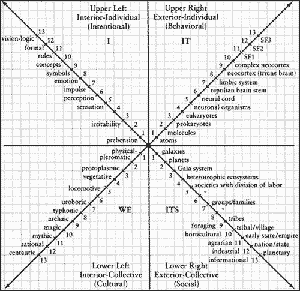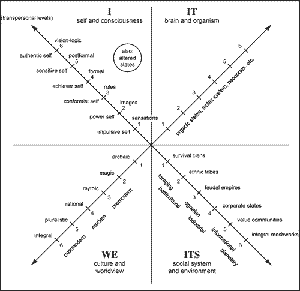In future columns, we will introduce the remaining elements of the integral approach, including developmental lines, states of consciousness, and types. When we are finished, all five elements-perspectives, levels, lines, states, and types-will hopefully be integrated into a seamless whole, which gives us a truly integral framework with which to better understand human spirituality and perhaps Spirit itself. But one thing that we have found time and again is that if you leave out any of those elements in your account of spirituality, you end up with a decidedly less-than-integral approach-which is to say, a partial, fragmented, broken approach to God. And, generally speaking, a broken God is not high on anybody's gift list.
Let us begin by integrating perspectives and levels. How do they fit together? Please see Figure 1. Notice that it is divided into four squares or quadrants. These quadrants are just another name for perspectives. You can see four of these important perspectives listed in their respective quadrants-"I" (the Upper-Left quadrant), "we" (the Lower-Left quadrant), "it" (the Upper-Right quadrant) and "its" (the Lower-Right quadrant).

Figure 1. The Four Quadrants (Click to enlarge image.)
Notice the contents of each of those quadrants. (Don't worry if all of the terms don't make sense; the diagram shows more details than we need, but the essential points should be obvious.) The Upper Right contains things like atoms, molecules, cells, organisms, triune brains, and so on. These are all things that can be seen "out there" in an objective fashion. Each of them is an "it" or third-person object. Science specializes in studying these types of objects.
The Upper Right is what an organism-e.g., your organism-looks like from an objective, detached, exterior, scientific approach. But notice that, unlike the Upper Right, the Upper Left cannot be seen "out there" in a scientific fashion, because the Upper Left contains things like feelings, ideas, wishes, interior states, even things like mathematics and logic, none of which can be seen running around out there in the sensory world, but can only be accessed by "looking within"-by introspection, awareness, contemplation, meditation, phenomenology, and so on. In figure 1, you can see a few representative items that you can be aware of if you introspect your own mind or awareness or experience-things like sensations, feelings, images, symbols, concepts, and so on, none of which can be see in the exterior world.
So the Upper Right is what your organism looks like from the outside in an objective stance, and the Upper Left is what your organism looks like from the inside, from within, in a subjective or introspective stance. The Upper Right is a third-person "it," but the Upper Left is a first-person "I"-hence, the outside and the inside views of your being. (Needless to say, an integral approach maintains that both of these are equally important for an overall picture. More about that later.)
So the two upper quadrants represent the inside and outside of an individual. But individuals always exist in collectives. There is no inside without an outside, and no singular without a plural. So the lower two quadrants represent the plural-the collectives or communities of individuals. And like individuals, these collectives, or societies, can be looked at from within and from without.
The fact is, societies, couples, groups, families, nations-and all of the plural or collective forms of beings-possess not just an outside but an inside. In addition to exterior forms that can be investigated by systems theory, they have interiors that can be investigated by other means. They have shared values, shared feelings, shared identities, shared cultures, shared worldviews-all of the items that can be found in the Lower-Left quadrant (or the interior of the collective). Figure 2 is a four-quadrant diagram drawn with an emphasis on some specifically human aspects of the quadrants. Some of these shared values and worldviews are listed in the lower left of Figure 2, such as magic, mythic, rational, postmodern, and integral.

Figure 2. Some Examples of the Four Quadrants in Humans (Click to enlarge image.)
Another way to get a sense of what the quadrants mean is to notice that many great philosophers and sages have specialized in one quadrant. This makes their discoveries very important-but also partial. Take a look at Figure 3 and you will recognize many of these pioneers.

Figure 3. Some Pioneers in the Various Quadrants (Click to enlarge image.)
You might have noticed by now that the four quadrants are simply a variation on the three major perspectives of first-person (I), second-person (you/we), and third-person (it/its). And those are variations on the Good (morals, you/we), the True (objective truth, it/its), and the Beautiful (the beauty in the "I" of the beholder). Further, each quadrant has development that proceeds through levels. In the previous Beliefnet column, I gave a summary of the levels of understanding of Spirit, and asked "Which Level of God Do You Believe In?" That was a good example of levels in one of the quadrants.
But the point is that quadrants and levels always go together. A simplified version of this can be seen in Figure 4 (taken from my book A Theory of Everything). This diagram, which we call AQAL ("All quadrants, all levels") is therefore an easy way to see how quadrants and levels always coexist. And the integral suggestion is that, if you leave out any of them, a broken God awaits you.

Figure 4. All Quadrants, All Levels (Click to enlarge image.)
The AQAL approach makes another strong claim, namely, that none of those quadrants can be reduced to the others. Each of them is an irreducible reality in its own right. Each quadrant contains realities that are crucial for a more comprehensive, balanced, and integral approach to reality, to the universe, to God and Goddess and Spirit. The integral approach maintains that if we take all of these important factors into account, then some of the truly difficult and intractable problems of religion and spirituality start to make sense-the relation of science and religion, the nature of humanity's relation to Spirit, the developmental levels of understanding God, the role of spirituality in the modern and postmodern world-among many others, which I would like to share with you in subsequent columns.
Accordingly, in our next Beliefnet column, we will begin exploring the many ways that an integral or AQAL framework can shed much-needed light on some of the most difficult problems facing religion in the modern and postmodern world. Because if this approach is generally correct, it offers, for the first time, a way to integrate premodern religion with modern science and postmodern developments, honoring each and every one of them in an integral embrace.
As a small preview, how about this: if you look at Figure 2, notice that many of the great spiritual teachers appear in the Upper-Left quadrant-but not in the other three quadrants. (Figure 2 mentions Buddha, Plotinus, and Aurobindo, but it could also list Jesus, Lao Tzu, Luria, Eckhart, St. Teresa, etc.) What if that is true, and it is the nature of religion or spirituality to offer us profound insights about that quadrant, but not the others? Would that hurt religion? Or could it possibly help religion by allowing it to specialize in what it does best, while conceding the other quadrants to other disciplines that historically have outshone religion in results? An integral approach that emphasized all quadrants and all levels would be able to integrate science and religion, premodern and modern and postmodern, but without diluting any of them. If that is the case, something rather revolutionary would be looming on the integral horizon.

